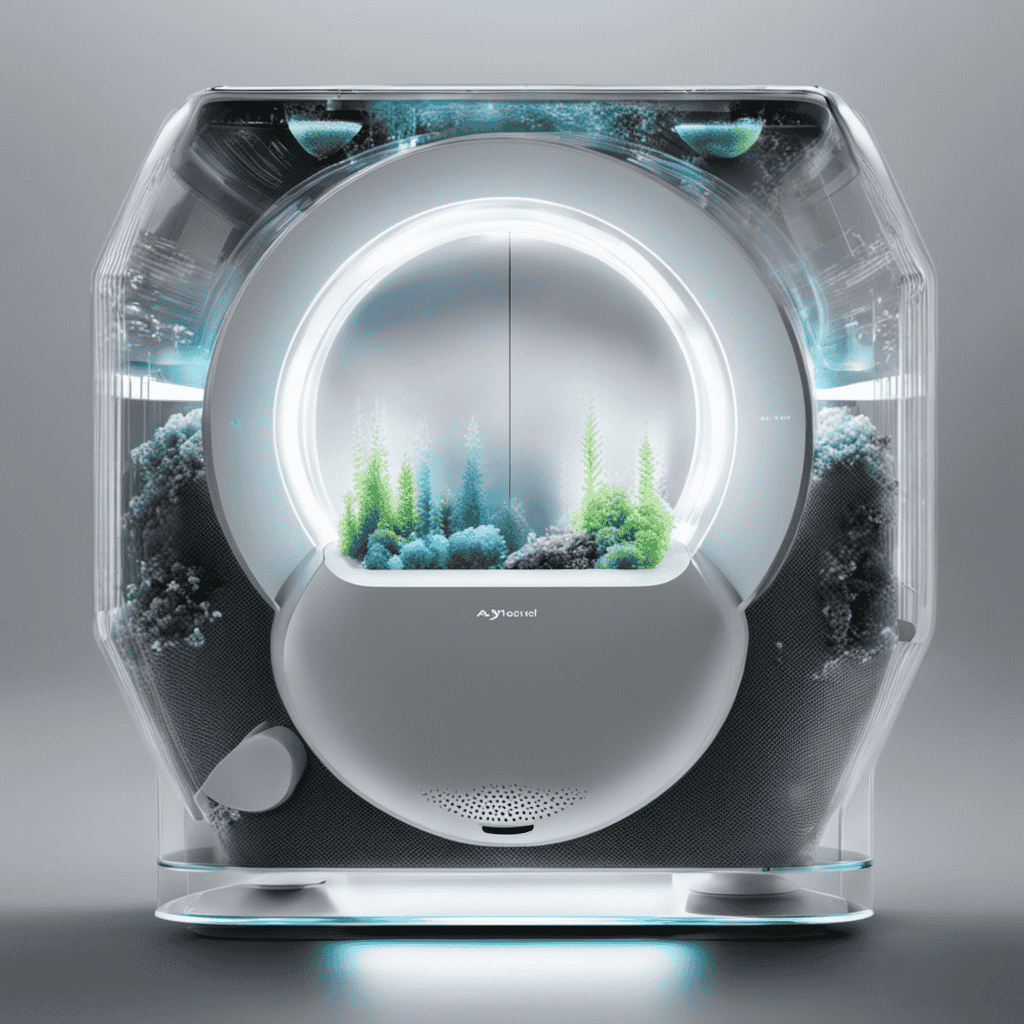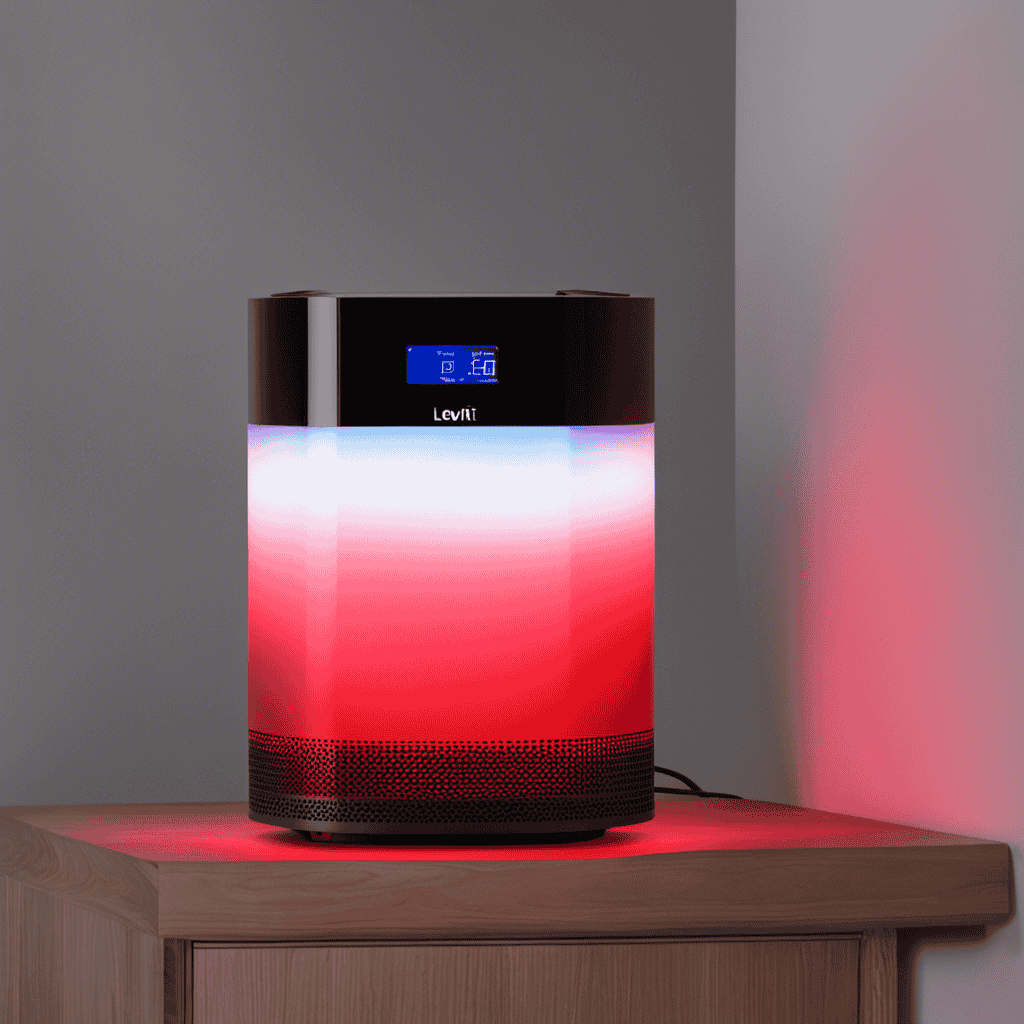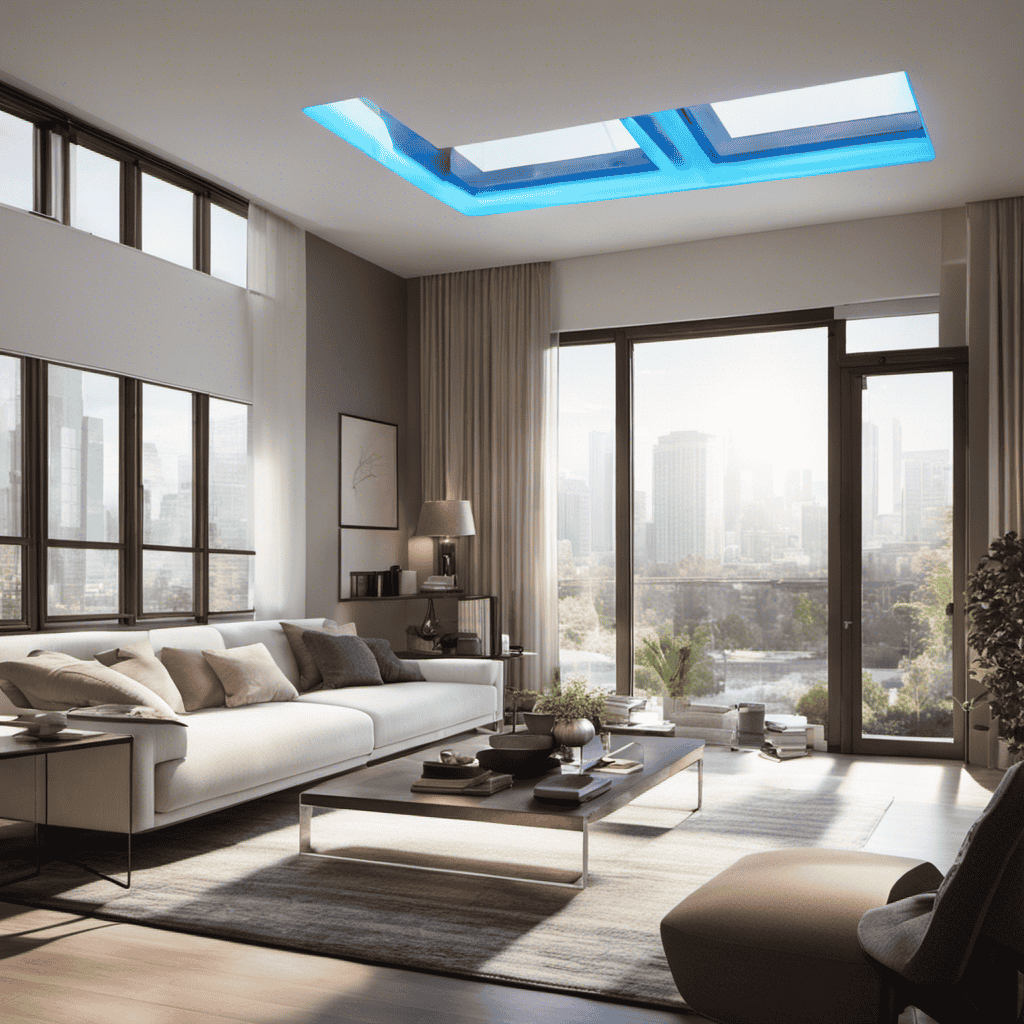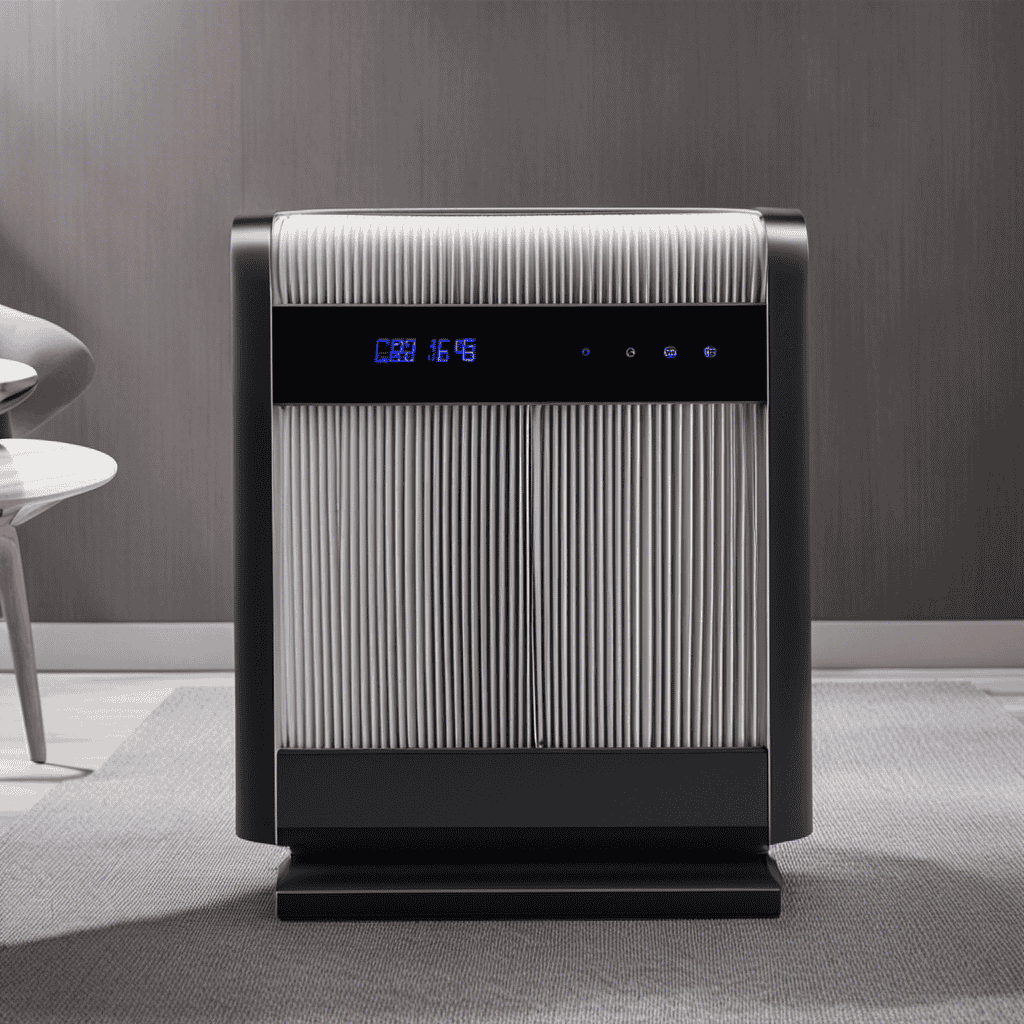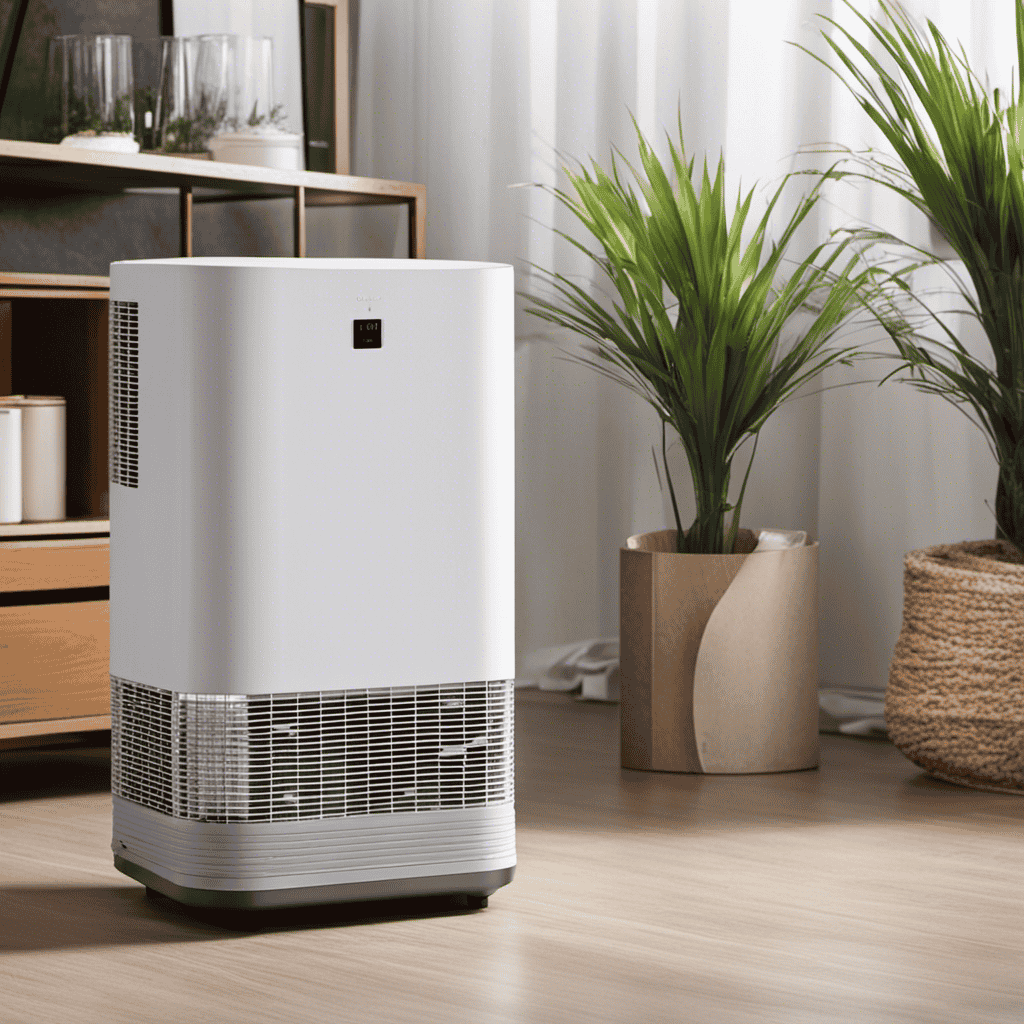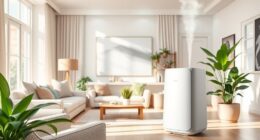As a fan of air quality, I frequently contemplate the details of air purifiers and how they recognize different pollutants. It’s intriguing to consider the technology powering these gadgets and how they diligently strive to enhance the air we inhale.
In this article, we will delve into the world of air purifier detection, exploring the different types of sensors used and their role in detecting dust particles, gas, odor, pollen, allergens, mold, mildew, and harmful VOCs.
Join me on this scientific journey as we uncover the secrets of air purifier detection.
Key Takeaways
- Air purifiers detect dust particles using laser-based particle counters, photocell sensors, electrostatic sensors, and optical sensors.
- Gas sensors in air purifiers detect and measure the presence of gases like carbon monoxide, nitrogen dioxide, and VOCs.
- Odor sensors analyze the chemical composition of the air to target and eliminate specific odors effectively.
- HEPA filters in air purifiers capture and remove particles as small as 0.3 microns, including allergens, dust, and bacteria.
Types of Sensors Used in Air Purifiers
There are several types of sensors used in air purifiers to detect pollutants and particles in the air. Air purifier sensor technology plays a crucial role in ensuring the effectiveness of these devices in improving indoor air quality.
One of the most common types of sensors is the particulate matter sensor, which detects and measures the concentration of fine dust particles in the air. These sensors use laser beams or light scattering techniques to analyze the size and number of particles present.
Another type is the volatile organic compounds (VOC) sensor, which detects and measures the level of harmful gases emitted by household products and building materials.
By monitoring these indoor pollutants, air purifiers can effectively filter and remove them from the air, ensuring a cleaner and healthier environment.
Now, let’s delve into how an air purifier specifically detects dust particles.
How Does an Air Purifier Detect Dust Particles
To detect dust particles, an air purifier uses sensors that measure the level of contamination in the surrounding air. These sensors play a crucial role in ensuring the effectiveness of the air purification process.
Here are four key mechanisms that air purifiers employ for particle detection:
-
Laser-based particle counters: These sensors use lasers to detect and count particles in the air. They can accurately determine the size and concentration of dust particles present.
-
Photocell sensors: These sensors work by measuring the amount of light scattered by particles in the air. By analyzing the intensity of scattered light, the sensor can estimate the particle concentration.
-
Electrostatic sensors: These sensors use an electric charge to attract and collect dust particles. By measuring the electric current generated, the sensor can determine the level of particle contamination.
-
Optical sensors: These sensors utilize light scattering or absorption techniques to detect and quantify dust particles.
Understanding the role of these dust detection mechanisms is crucial in comprehending the overall functioning of an air purifier.
Now, let’s delve into the next section, which explores the significance of gas and odor sensors.
Understanding the Role of Gas and Odor Sensors
Let’s explore how gas and odor sensors play a key role in ensuring the effectiveness of your air purification process.
Gas detection and odor elimination are vital aspects of maintaining clean and healthy air in our surroundings. Gas sensors are designed to detect and measure the presence of various gases in the air, such as carbon monoxide, nitrogen dioxide, and volatile organic compounds (VOCs). By continuously monitoring these gases, the air purifier can take appropriate actions to filter them out and maintain air quality.
Odor sensors, on the other hand, are responsible for detecting unpleasant smells in the environment. They work by detecting and analyzing the chemical composition of the air, allowing the air purifier to target and eliminate specific odors effectively.
Together, gas and odor sensors ensure that the air purification process is efficient and capable of providing clean and fresh air.
The Importance of HEPA Filters in Air Purifier Detection
When it comes to air purifiers, one of the most important factors to consider is the effectiveness of the HEPA filters.
HEPA filters are designed to capture and remove particles as small as 0.3 microns, including allergens, dust, and bacteria.
Studies have shown that using air purifiers with HEPA filters can significantly improve indoor air quality, reducing the concentration of pollutants and allergens in the air.
Additionally, the filtration provided by HEPA filters can have numerous health benefits, such as reducing respiratory symptoms and improving overall respiratory health.
HEPA Filter Effectiveness
You can trust that the HEPA filter is effective in capturing small particles such as dust, pollen, and pet dander. The efficiency of a HEPA filter is crucial for the overall performance of an air purifier.
Here are some key points to consider:
- HEPA filters have a minimum efficiency of 99.97% in capturing particles as small as 0.3 microns.
- The filter’s dense fiber structure traps particles effectively, preventing them from recirculating back into the air.
- HEPA filters are designed to capture both larger particles and microscopic pollutants, ensuring cleaner and healthier air.
- Regular maintenance, such as changing the filter as recommended by the manufacturer, is necessary to maintain the filter’s efficiency.
With a highly efficient HEPA filter, you can be confident that your air purifier will effectively remove a wide range of airborne pollutants, improving the overall air quality in your indoor environment.
Air Quality Improvement
Improving indoor air quality is crucial for maintaining a healthy living environment. Clean air is essential for our overall well-being, as it can reduce the risk of respiratory illnesses and allergies. One effective way to improve air quality is by using an air purifier. Regular air purifier maintenance is important to ensure its optimal performance.
Here are some benefits of clean air and the importance of air purifier maintenance:
| Benefits of Clean Air | Air Purifier Maintenance |
|---|---|
| Reduces respiratory illnesses | Regularly replace filters |
| Minimizes allergy symptoms | Clean the unit regularly |
| Removes airborne pollutants | Check for any malfunctions |
| Eliminates unpleasant odors | Keep the unit in a well-ventilated area |
| Improves sleep quality | Follow manufacturer’s instructions |
Health Benefits of Filtration
Maintaining regular air purifier maintenance helps ensure that the filtration system effectively removes airborne pollutants from your indoor environment. This is crucial for maximizing the health benefits of an air purifier.
Here are some advantages of filtration:
-
Removes allergens: The filtration system in an air purifier is designed to capture and trap allergens such as pollen, dust mites, and pet dander, providing relief for individuals with allergies.
-
Reduces respiratory irritants: Filtration removes particles that can irritate the respiratory system, including smoke, smog, and volatile organic compounds (VOCs).
-
Eliminates odors: The activated carbon filters in air purifiers help absorb and neutralize unpleasant odors caused by cooking, pets, and other sources.
-
Improves overall air quality: By removing harmful pollutants, an air purifier can significantly improve the overall air quality, reducing the risk of respiratory problems and promoting a healthier living environment.
How Does an Air Purifier Detect Pollen and Allergens
To detect pollen and allergens, an air purifier uses sensors to identify and capture particles in the air. These sensors are equipped with advanced detection mechanisms that allow them to effectively detect and trap allergens.
The effectiveness of allergen detection is crucial for an air purifier to provide clean and purified air. The sensors are designed to detect even the smallest particles, such as pollen, dust mites, pet dander, and mold spores. They work by continuously monitoring the air and analyzing the concentration of particles present.
When allergens are detected, the purifier activates its filtration system, which includes HEPA filters, activated carbon filters, and sometimes even UV-C light technology, to effectively capture and remove these allergens from the air. This ensures that the air purifier effectively reduces allergens in the environment, providing cleaner and healthier air for individuals with allergies or respiratory conditions.
Exploring the Technology Behind Air Purifier Detection
In the previous subtopic, we discussed how air purifiers detect pollen and allergens. Now, let’s delve into the technology behind air purifier detection and explore advancements in this field.
With the continuous evolution of technology, air purifier detection has seen significant advancements. Researchers and engineers are constantly working towards improving the accuracy, sensitivity, and efficiency of air purifier sensors.
Here are some key advancements and the future of air purifier sensors:
-
Advanced Particle Counting: New sensors can now detect particles as small as 0.3 micrometers, allowing for the capture of even the tiniest contaminants.
-
Gas Sensors: Air purifiers equipped with gas sensors can detect and remove harmful gases, such as volatile organic compounds (VOCs) and formaldehyde.
-
Smart Sensors: Future air purifiers may have smart sensors that can adapt to changing indoor air quality conditions and adjust purification settings accordingly.
-
Internet of Things (IoT) Integration: Air purifiers may become part of a connected network, enabling real-time monitoring and control through smartphone apps or voice assistants.
With these advancements, the future of air purifier sensors looks promising, offering more effective and personalized indoor air purification solutions.
The Science of Air Purifier Detection: Mold and Mildew
With the advancements in air purifier sensor technology, you can now effectively identify and remove mold and mildew particles from your indoor environment. Air purifiers are equipped with specialized sensors that can detect and target these harmful substances, providing cleaner and healthier air for your home or office. One of the key factors in mold and bacteria detection is moisture and humidity control. Mold and mildew thrive in damp environments, so by monitoring and controlling the moisture levels in the air, air purifiers can help prevent the growth and spread of these harmful particles. Additionally, air purifiers may utilize advanced filters and UV-C technology to further eliminate mold and bacteria, ensuring a safe and clean indoor environment.
| Sensor Technology | Benefits |
|---|---|
| Moisture Sensors | Detect and control humidity levels |
| Mold Detectors | Identify and target mold particles |
| Bacteria Sensors | Detect and remove harmful bacteria |
Detecting Harmful Vocs With an Air Purifier
When it comes to air purifiers, one important capability is their ability to detect and remove harmful VOCs (volatile organic compounds).
VOCs are organic chemicals that can have negative health effects when present in high concentrations indoors.
Air purifiers equipped with VOC sensors can detect these compounds in the air and take action to remove them, improving indoor air quality.
In this discussion, we will explore the science behind air purifier VOC detection and the importance of sensing and removing harmful VOCs for a healthier living environment.
Air Purifier VOC Detection
Did you know that an air purifier can detect VOCs in your home? Air purifiers are equipped with advanced technology that allows them to effectively detect and remove volatile organic compounds (VOCs) from the air.
Here are some key points about air purifier VOC detection:
-
Sensors: Air purifiers are equipped with sensors that can detect the presence of VOCs in the air. These sensors can accurately measure the levels of VOCs and alert you if they exceed safe levels.
-
Filtration: Air purifiers use different types of filters, such as activated carbon filters, to effectively capture and remove VOCs from the air. These filters have a large surface area that can trap and absorb VOC molecules.
-
Technology: Air purifier technology has advanced significantly in recent years, allowing for more accurate and efficient VOC detection. Some air purifiers even have smart features that can monitor VOC levels in real-time and adjust the purification settings accordingly.
-
Effectiveness: Studies have shown that air purifiers can effectively reduce VOC levels in indoor spaces, improving air quality and reducing the risks associated with VOC exposure.
Overall, air purifiers play a vital role in detecting and removing VOCs from the air, making them an essential tool for maintaining a healthy indoor environment.
Harmful VOC Sensing
Harmful VOCs can be sensed and detected by advanced technology in air purifiers. These devices are equipped with sensors that can identify and measure the concentration of volatile organic compounds in the air. This is crucial for maintaining good indoor air quality and protecting our health.
One of the most effective ways an air purifier can remove VOCs is through the use of activated carbon filters. These filters are designed to trap and absorb the harmful chemicals, effectively removing them from the air. Additionally, some air purifiers also utilize photocatalytic oxidation technology, which breaks down VOCs into harmless byproducts.
To further illustrate the importance of VOC removal, here is a table showcasing some common harmful VOCs and their potential health effects:
| VOCs | Health Effects |
|---|---|
| Formaldehyde | Eye, nose, and throat irritation |
| Benzene | Headaches, dizziness, and confusion |
| Toluene | Nervous system damage |
| Xylene | Respiratory and neurological symptoms |
| Trichloroethylene | Liver and kidney damage |
Frequently Asked Questions
Can an Air Purifier Detect Harmful Chemicals in the Air?
Yes, an air purifier can detect harmful chemicals in the air. It uses advanced sensors to detect pollutants and chemical sensitivities, providing real-time data on air quality and enabling effective purification.
What Is the Difference Between a Sensor-Based Air Purifier and a Filter-Based Air Purifier?
As an expert in air purification, I can tell you that the difference between sensor-based and filter-based air purifiers is significant. Sensor-based purifiers use advanced technology to detect and eliminate pollutants, while filter-based purifiers rely on physical filters to trap particles. Each has its pros and cons, depending on your specific needs.
How Does an Air Purifier Detect and Eliminate Pet Dander and Pet Hair?
An air purifier detects and eliminates pet dander and pet hair through its sensor-based technology, which detects the presence of allergens in the air. Regular air purifier maintenance is crucial for optimal performance. When choosing an air purifier for pet allergies, consider its filter efficiency and coverage area.
Can an Air Purifier Detect and Remove Viruses and Bacteria From the Air?
Yes, an air purifier can detect and remove viruses and bacteria from the air. Using advanced air purifier technology, it effectively eliminates harmful microorganisms, providing a cleaner and healthier indoor environment.
How Often Should Sensors in an Air Purifier Be Replaced or Calibrated for Accurate Detection?
The replacement frequency and calibration accuracy of sensors in an air purifier depend on various factors such as the model, usage, and environmental conditions. Regular maintenance and following the manufacturer’s guidelines are crucial for accurate detection.
Conclusion
In conclusion, understanding how an air purifier detects various pollutants is crucial for creating a healthy and clean indoor environment.
Just like a detective solving a mystery, an air purifier utilizes a range of sensors to uncover hidden particles and gases. These sensors act as the purifier’s keen eyes and nose, sniffing out dust, pollen, mold, and harmful VOCs.
With the help of HEPA filters, the air purifier filters out these contaminants, providing us with fresh and pure air to breathe. It’s like having a vigilant guardian ensuring the air we breathe is free from pollutants, just as a detective ensures a crime scene is thoroughly investigated.
So, let your air purifier be your home’s detective, working tirelessly to keep your air clean and safe.
